History of the Queensland Police
The history of the Queensland Police Service in Queensland, Australia, commenced in 1864, five years after the Separation of Queensland from New South Wales in 1859. This timeline highlights significant developments in Queensland policing.
.jpg)
1860s
The uniform worn by Queensland police officers after separation in 1859 was a dark blue jacket and top with a forage cap, supplied by the New South Wales police.[1]
1864
The Queensland Police Force was established by the Queensland Government on 1 January 1864 with strength of 287 officers serving a population of 61,467. David Thompson Seymour appointed as Acting Commissioner and later as Commissioner.[1]
Transport in the settled areas was mainly by foot and in the unsettled areas by horse.[1]
The hulk Margaret Eliza was purchased for £3000. It was refitted and renamed the Proserpine. She was used as a floating water police office, prison, and later as a reformatory school.[1]
Correspondence with the Police Commissioner or between stations was by handwritten letter, moved by horse or Cobb and Co stagecoach, or by telegram.[1]
Finding that no written instructions had ever been issued for the guidance of the police, Commissioner Seymour issues "Rules for the General Government and Discipline of members of the Police Force of Queensland" based upon the Victorian police model.[1]
On 1 December, the Detective Office was created with Sub-Inspector George Elliott in charge.[1]
At December 1864, in the first year of operation of the Queensland Police Force, there were 27 ordinary police stations with 151-foot and mounted officers, and 16 native police camps of 136 European officers and indigenous troopers. Twenty of the 'ordinary police force' stations averaged four officers each, the bigger stations like Brisbane, Ipswich, Rockhampton and Maryborough had larger staff numbers. Native police camps averaged between 7 and 17 men, large camps like Rockhampton could have up to 27 men of both officers and troopers.[2]
1865
Police Commissioner David Seymour described the lack of accommodation for police: "Many men are compelled to live in lodgings, and in the country districts constables live in public-houses some distance from the lock-up at times making them unavailable for sudden emergencies".[1]
Police Commissioner Seymour focussed on the crime of bushranging and took active measures to hasten the capture of these criminals through the purchase of fresh police horses and the construction of securely fenced paddocks at every police station.[1]
Water police were stationed on board the Hulk Proserpine at the mouth of the Brisbane River.[1]
Revolvers were supplied to every police station and 50 breech-loading carbines were delivered to the Department.[1]
1866
The Bread or Blood riot started, threatening the sacking of Government House in Brisbane. Hundreds of government officials were sworn in as Special Constables to assist police.[1]
The first uniform consisted of a Garibaldi jacket of dark blue, serge wool cloth, red facings, and shoulder knot; trousers of the same material, with red cord, and a high cap with French peak.[1]
1867
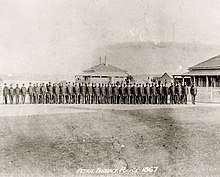
On 6 November 1867 Constable Patrick William Cahill and Constable John Francis Power were poisoned and shot in the head at the MacKenzie River Crossing while escorting a consignment of bank notes and bullion from Rockhampton to Clermont.[3] The first major test for the Detective Office was to solve their murders.[1]
Police Commissioner Seymour stated that "men at all stations are, when practicable, to be drilled once a week".[1]
1870s
Navy blue helmets were introduced and proved to be a very hot choice of headwear; they were phased out in favour of white helmets in 1896.[1]
1870
A police barracks was established in George Street, Brisbane, on the site of the old convict hospital.[1]
Changes to rank insignia were implemented which among other things meant that an Acting Sergeant would be called a Senior Constable.[1]
1872
A general order was issued that the Chinese had as much right on the gold fields as Europeans, so long as they had a miners' permit. If a collision resulted in a riot which the police could not quell, they were to note the ring-leaders and apprehend them.[1]
1873
Sub-Inspector Robert Johnstone, officer in charge of native police, accompanied explorer George Dalrymple on the north-east coast expedition to explore the coastal lands as far as Cooktown.[1]
1875
The bulk of the Queensland Police force moved from the Brisbane CBD to Victoria Barracks and occupies the army buildings on site.[1]
Three movable houses and twelve large frame-tents were built in Brisbane and shipped to the Palmer River gold-field. They were quickly erected by two constables and could house six officers.[1]
1876
The Police Manual instructed constables on beat duty to "possess such knowledge of the inhabitants of each house as to enable them to recognise their persons; and thus prevent mistakes, and be enabled to render assistance, when called upon, to the inhabitants".[1]
"Instructions for the Guidance of the Police" were published and a system of competitive examination for promotion was introduced, intended to increase police efficiency.[1]

1877
Laura Police Station opened in 1877 with Sub-Inspector 1/c Hervey Fitzgerald in charge. As at 2019, it was still a single officer station today and was staffed by a Senior Constable.[2]
1880s
1880
At Birdsville, locally-available cane grass was used on police station walls for its insulation properties and longevity.[1]
Native Police camp accommodation was constructed using a variety of materials, such as saplings, logs, bark, canvas and shingles.[1]
1881
On 24 January Sub-Inspector George Dyas was found buried after being killed by being speared in the back by Aboriginals while he camped near the 40 Mile Waterhole near Normanton.[3]
On 24 September Sub-Inspector Henry Kaye died from being speared through the chest by Aboriginals at Woolgar gold fields (100 km north of Richmond).[3]
1882
Sub-Inspector 1/c Alexander Douglas was sent to Herberton and with four troopers, two old gold diggers and five Chinese men; he blazed a trail from Herberton to Mourilyan. The party travelled without rations and in continuous rain for twenty days, living mainly on roots.[1]
Martini-Henry rifles were purchased to replace the Snider previously used.[1]
1883
The Petrie Terrace Gaol area was taken over by the Queensland Police and became known as the Petrie Terrace Police Depot where prospective police officers were trained.[1]
On 24 January Cadet Sub-Inspector Mark Beresford died after being speared in the thigh and hit on the head by Aboriginals in the Selwyn Ranges to the south of Cloncurry.[3]
On 26 January Constable William Dwyer was struck on the head by a tomahawk and killed by an Aboriginal near Juandah Station via Taroom.[3]
1884
Cap badges consisting of a separate district letter and number were issued and remained in use until 1906.[1]
As policing reached across the state more and more stations were opened usually in small towns of less than 300 people or in places that were growing due to the building of train lines or the discovery of gold. By December 1884, twenty years after the inauguration of the Police Force, there were 155 stations with 657 police officers and 182 indigenous troopers and trackers. There was also a growth in the number of single officer stations. In 1884, 36 stations were operated by single police officers, of these 6 were assisted in their duties by an indigenous tracker.[2]
Running a police station with one officer was a daunting task. Often there was no station building and one had to be rented or moves made to purchase something suitable. Married officers were generally not sent to single officer stations as there was generally no accommodation for them in town. However, wives who did join their husbands, found themselves looking after the station and taking enquiries, while her husband was away. Her tasks could also involve feeding and cleaning up after prisoners in the lock-up.[2]
1886
The first six camels arrived in Birdsville from India in poor condition and by July only four had survived. Despite these early setbacks camels proved useful, travelling hundreds of kilometres on duties such as collecting statistical returns.[1]
1887
The first honour given to any Queensland police officer was a Royal Humane Society Bronze Medal awarded to Constable James O"Brien for saving the life of a nine-year-old boy at Ipswich.[1]
During the Burketown cyclone on 5 March, Sergeant John Ferguson"s wife kept a lamp burning in the window of the courthouse and her beacon drew many people to the refuge during the storm.[1]
1889
A Royal Commission of Enquiry into the Police Force proposed sweeping changes including that the control of the section of Water Police known as River Police was given back to the police Commissioner.[1]
The cost of buying ordinary clothing for plain clothes work was an extra burden that detectives had to meet out of their ordinary pay.[1]
There were eleven detectives on the pay-roll across the state. Seven in Brisbane, two in Townsville, and one each in Normanton and Rockhampton.[1]
On 27 October Senior Constable Alfred Wavell was shot and killed at Corinda (southwest of Burketown) by a man who had escaped from the Normanton lock-up.[4]
1890s

1891
Senior Sergeant Martin Breene and Constable Joseph Waters displayed energy and perseverance during the shearer"s strikes by following and preventing "fire gangs" from doing damage at Lammermoor pastoral station.[1]
Eromanga Police Station was first opened on 26 September 1891 in a two roomed cottage rented at a cost of five shillings per week, with Senior Constable Manuell in charge. At this time the township consisted of one large store owned by Mr W Paterson, two first class pubs built of brick, and a couple of "humpys". The resident population was about 20 and there was always a number of men from the opal mines and stations "knocking down their cheques" (spending their money) at Eromanga’s pubs. Senior Constable Manuell remained in charge of Eromanga until he was instructed to close this station on 31 December 1891, and to proceed to Thargomindah. The station reopened in 1893. In 1894, the first police residence was built so the police officer have his wife live with him. As at 2019, it was still a single officer station and was staffed by a Senior Constable.[2]

1893
During the shearer"s strike, police were given sole power to "preserve order and secure liberty to all alike".[1]
Acting Sergeant John Raphael Thompson was paid £10 extra to attend to photographic work which included mug shots and crime scene photography.[1]
On 4 February Constable James Sangster, 25, drowned attempting a rescue of two members of the Jackson family during the 1893 flood of the Bremer River at North Ipswich.[4] He is commemorated by the James Sangster Memorial at North Ipswich, which was initiated by the Jackson family and funded by public subscription. The monument has a broken obelisk which symbolises a life cut short.[5]

MacKinlay (now McKinlay) Police Station was opened in 1893.[2]
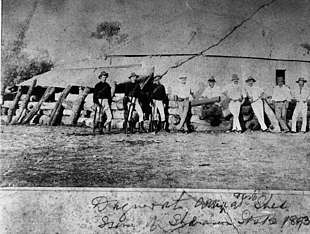
1894
On 10 May Constable Benjamin Ebbitt died at South Brisbane having never recovered from an assault during an arrest on 9 November 1890 at Croydon.[4]
On 6 September Constable Edward Lanigan was killed by being shot in the chest while trying to prevent another policeman from being shot during an arrest at Montalbion (a mining town near Irvinebank).[4]
1895
On 30 June, Commissioner Seymour retired after 31 years in the job and was replaced by William Edward Parry-Okeden on 1 July. Full control of the water police finally came under the jurisdiction of Police Commissioner.[1]
On 2 July Senior Constable William Conroy died after being stabbed several times trying to prevent a man from stabbing the man's wife on Thursday Island.[4]
The Roma Street police station telephone exchange was connected to fourteen sites including the Woolloongabba and South Brisbane police stations, the Commissioners house at Red Hill, the Detective Office, the Police Depot and the Central Fire Brigade Station.[1]
1896
The bicycle, as a means of transport was introduced and a slow distribution occurred across the state. At about £13 a bicycle was more expensive than a horse.[1]
Detectives received no special training. Generally, "the smartest and most intelligent' people from among the plain clothes officers in the general police were selected and expected to learn from experience.[1]
The Pearl ferry capsized near the Victoria Bridge on the flooded Brisbane River on Valentine's Day. After the rescue of sixty survivors, police made every effort to recover and identify the bodies of the twenty-nine victims.[1]
A loose tunic was adopted in place of the existing jumper for police uniform. Mounted officers performing mounted duty, wore Bedford cord breeches and black napoleon boots.[1]
1897
The collection housed in the "Police Museum" running since 1893, was used to educate recruits about criminal methods.[1]
1899
On the trail of an escapee, Constable James Kenny and four indigenous troopers survived Cyclone Mahina at Bathurst Bay, by staying together after their camp was blown away.[1]
The recruit probation period was increased so that no man was sworn until three months' drill and instruction was completed at the Police Depot.[1]
Englesburg police station was opened on 25 April 1899. The town's name was changed to Kalbar in September 1916 due to anti-German sentiment in World War I.[2]
1900s
1900
At the turn of the century the Queensland Police Department had 845 police officers and 135 native trackers at 256 stations.[1]
1901
First-Class Constable George Pugh displayed discretion and bravery in the single-handed arrest of three men for the unlawful killing of cattle at the Jundah Opal Fields, and for taking them on foot, the twenty miles to Jundah police station.[1]
The Criminal Investigation Branch moved into the old St John's Cathedral synod building on the corner of Elizabeth and George Streets.[1]
1902
The Imperial Service Order and Medal was established by King Edward for the administration and clerical staff of the Civil Service throughout the British Empire for long and meritorious service.[1]
On 30 MarchConstable George Doyle was shot while attempting to capture the Kenniff brothers, who had a long history of stealing cattle and horses, in Upper Warrego.[4]
1903
In May the Bronze Medal of the Royal Humane Society was awarded to First-class Michael Becher, Inspector Percy Galbraith, Constables Charles Pinwill and William Ryan who risked their own lives to save the lives of others between 12 November 1889 and 15 January 1903.[1]
On 29 March Acting Sergeant David Johnston was killed by being hit on the head with an axe by a prisoner in the watchhouse at Mackay.[4]
1904
The Fingerprint Bureau was established. During the first year of operation 578 fingerprints were taken and 226 came from other states.[1]
On 16 September 1Constable First Class Charles O'Kearney was knocked down and killed by a horse being deliberately ridden towards him in retaliation for an arrest in Laidley.[6]
1905
William Geoffrey Cahill became the third Police Commissioner on 1 April 1905.[1]
On 23 December Constable Albert Price was stabbed and killed while making an arrest at Mackay.[6]
1906
.jpg)
.jpg)
On 27 September 1906: Sergeant Thomas Heaney died at South Brisbane from head fractures sustained when he was hit multiple times over the head with a metal bar during an arrest on 7 June 1905 at Woolloongabba, Brisbane.[6]
On 4 October Police Commissioner Cahill announced the establishment of a Medal for Merit departmental award for police officers who displayed pre-eminent bravery on duty. The first two medals were awarded to Acting Sergeant John Hennessy and Constable Richard Runge on 12 October.[1]
Queensland police enforced the Infant Life Protection Act of 1905 by checking the registration of births and the deaths of illegitimate children.[1]
1907
The Patrol was the first motorised vessel used by the Brisbane Water Police. She was capable of 8 knots (15 km/h; 9.2 mph).[1]
Constable Charles Watson and a tracker followed suspected murderer J.W Patterson for 350 miles (560 km). They captured the fugitive but had very little food or water for the last 100 miles (160 km) of the chase.[1]
A new Figure-of-8 style handcuff was introduced.[1]
In 1907, Police Commissioner William Cahill and the Deputy Queensland Government Architect, designed the Queensland Police Station Badge based on the police cap badge of the time. Prior to this time, there was no standard way to indicate a police station.[7]
1909
A very fine 78,000-acre (32,000 ha) reserve called Rewan was proclaimed as a stud farm for breeding police horses. The Woodford mares and foals as well as two purchased stallions, "Libertine" and "Mack" populated the reserve.[1]
Very few police stations have a typewriter and some officers use their own to complete reports and correspondence.[1]
The Kings Police Medal was instituted by King Edward VII on 7 July to be awarded to those officers of properly recognised police forces and fire brigades under the jurisdiction of the sovereign, who showed distinguished service and conspicuous devotion to duty, or who carried out heroic acts of courage. First awarded to Constable John Bourke on 29 August 1911.[1]
The good will of the community was necessary if an officer was to be able to carry out his duties effectively while in town and to then to be confident that nothing untoward would happen while he was away checking the rest of his beat by horse. Communities were often loath to let an officer go when he was transferred away and often took up petitions and wrote letters to the Police Commissioner begging for the officer to remain in town. Long standing officers were often presented with gifts and highly decorated letters of thanks from their community. When Sergeant Lawrence Clare was transferred in March 1909, the citizens of the Esk District expressed their thanks:[2]
Highly decorated missive presented to Sergeant Lawrence Clare by the citizens of the Esk District when he was transferred in March 1909To
Sergeant L. J. Clare
Together with a Purse of Forty Sovereigns
From his many friends in the Esk Police District
Dear Sir
We, the residents of Esk and District, desire to approach you with the purest sentiments of congratulation at the close of your most efficient service of Ten Years as Constable and Sergeant in charge of our large District. Those who have been associated with you will long cherish your courtesy and untiring zeal in carrying out at all times your official duties with credit to yourself and the Department in which you are engaged. In presenting you with the accompanying gift we are deeply sensible that it is in no sense an adequate measure of your excellent qualities and labours; nor do we wish you to regard it in the light of a recompense but ask you to accept it as a mark of our regard. In conclusion, we sincerely wish that both yourself and your family will in future have every happiness and prosperity.
Signed for on behalf of the Subscribers.
Alex Smith, Chairman Esk Shire Council
1910s
1910
Inspector White reported that nearly every station within a five-mile radius of the centre of Brisbane was connected by telephone.[1]
Chief Inspector Urquhart favourably mentioned Constable Peter Hagarty of Finch Hatton: "he is an exceptional good man in a rough place among a very rough class of people. He made seventy-one arrests single handed this year and is most highly spoken of by the respectable portion of the community".[1]
1911
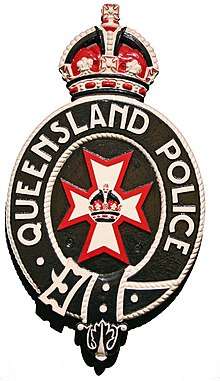
In 1911, 300 cast iron station badges, each weighing 17 pounds (7.7 kg) and costing £0/4/10, were manufactured for the Police Department by Harvey & Son, Globe Iron Works, Brisbane and distributed as identification badges to every police station in Queensland.[7]
First reference to the idea of women police was made by the National Council of Women of Queensland.[1]
1912
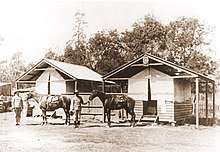
The 1912 Brisbane general strike started as a tramway strike but gains momentum with 20,000 or more people withholding their labour and brings industry to a standstill. Mass rallies see police numbers bolstered by the swearing in of 3,000 Special Constables.[1]
1914
Police stations serve a variety of local community needs and police officers were expected to act in extraneous roles as representatives for the government.[1] World War I begins.
1915
Police Commissioner Cahill rejects the idea of employing women following an enquiry by the Acting Home Secretary.[1]
1916
The strength of the Force on 30 June, was 1037 general police, 30 Criminal Investigation Branch officers, 11 water police officers, 99 indigenous police, 27 recruits and 89 on leave with the Commonwealth Military Forces on active service in World War I.[1]
At 13 July, four-year old Nicholas Frousheger wandered away from his home about three miles south of Charleville. The media reports that "the police, and a large party of civilians are trying hard to overtake him, but it is difficult owing to the stony ridges and the light imprint left by the little one".[1]
1917
Frederic Charles Urquhart becomes the fourth Police Commissioner on 1 January 1917.[1]
1918
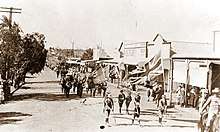
World War I ends.
1919
On 24 March, 8,000 soldiers and conservatives march on the Russian émigré headquarters at South Brisbane which leads to violent clashes between protestors and police. This uprising was known as the Red Flag Riots or Red Monday.[1]
1920s
1920
Bicycles, not cars, were the usual means of transportation used by police for the prevention and detection of crime. Police Commissioner Ryan establishes bicycle patrols so that plain clothes officers could keep the suburbs of Brisbane under surveillance at night time.[1]
1921
An explosion at Mount Mulligan Colliery entombs over seventy miners. Residents, men from a neighbouring mine assist Constable James O"Dwyer in efforts to recover deceased miners.[1]
Patrick Short became the fifth Police Commissioner on 16 January 1921.[1]
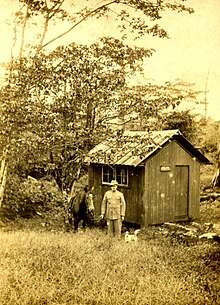
1922
Millaa Millaa police station opened in 1922. The first officer to be stationed at Millaa Millaa was Constable Daniel Dwyer. As at 2019, it was still a single officer station and was staffed by a Senior Constable.[2]
1924
The first thorough revision of "Rules for the general government and discipline of the members of the Police Force of Queensland" was completed.[1]
1925

779 horses were in service, three camels were obtained for Noccundra police station and three new Harley-Davidson motorcycles with side cars were purchased.[1]
William Harold Ryan becomes the sixth Police Commissioner on 15 January 1925.[1]
1926
The first two motorised vehicles were Black Marias or prison vans, one of which utilised the body from a horse-drawn prison van on the back of a Bean truck chassis.[1]
1927
The Criminal Investigation Branch building in Queen's Park, was blown up by a criminal intent on destroying the evidence against him.[1]
Retired Sergeant 2/c William Lynam had the gruesome job of burying seventeen Ingham flood victims, men, women, and children of three Italian families "on the nearest patch of dry land I could find".[1]
Dustcoats and overalls were worn by members of the Criminal Investigation Branch when riding on motorcycles to prevent dust and oil from staining clothing.[1]
1928
There was only one detective available to handle criminal investigations between Townsville and Cloncurry.[1]
1929
Inspector Loch describec Cecil Plains as "a large pastoral and farming district with large areas of thickly timbered and pear infested ground that gives stock thieves excellent opportunity to carry out their work.[1]
1930s

1930
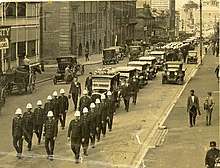
On 6 August 1930 Constable Ernest James Dawson was on traffic duty on the Yungaburra Road near Lake Barrine when he lost control of his motorcycle. Despite emergency surgery which appeared initially successful, complications arose and he died in Brisbane General Hospital on 18 January 1931.[8] There was a huge funeral procession in his honour on 19 January 1931.[9]
1931
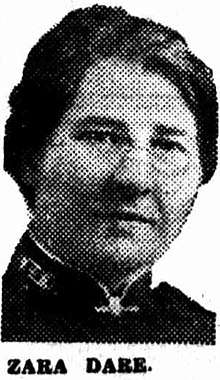
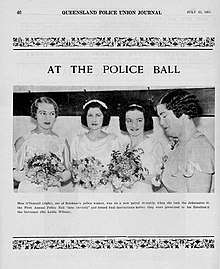
The first two women police, Miss Zara Dare and Miss Eileen O'Donnell were appointed on 16 March, after Queensland Cabinet supported a submission by Irene Longman, Queensland's first female Member of the Queensland Legislative Assembly. They were attached to Roma Street police station in the centre of Brisbane but were not sworn-in and had no powers of arrest. They did not have a uniform but were given a badge. Their duties were to protect the interests of women and children.[1][10]
1932
On 5 January, four-year-old Betty Doherty was taken by 4-metre (13 ft) crocodile as she plays near the Seymour River, about twelve kilometres east of Halifax. Acting Sergeant Frank Conaty and Constables George Schnitzerling, Jens Fredericksen and Arnold Still made an extensive search but fail to find any trace of the child.[1]
1934
Cecil James Carroll becomes the seventh Police Commissioner on 8 May 1934.[1][11][12]
A special squad of traffic police was organised for the control of the Brisbane traffic district.[1]
The Battley Single Finger Print System was adopted, to reduce the period of search for a print found at the crime scene among the 470,000 impressions held.[1]
Carroll introduces the police cadet system to admit applicants of 18 years with a junior pass or a senior level school certificate.[1]

Carroll initiated the establishment of the Queensland Police Welfare Club which was located within Roma Street police station and served alcohol as well as offering recreational amenties such as a library, billiard tables and darts boards. Six weeks after its establishment the Club held its first ball at the Brisbane City Hall on 1 August 1934. Over 2,000 people attended and was believed to be the largest function of its kind ever held in Brisbane. The balls were an annual event and were held at Brisbane City Hall until the 1960s when they relocated to Cloudland Ballroom; the balls ceased in the 1970s.[13]
1935
The Modus Operandi Section was established by Police Commissioner Carroll as a central repository for criminal records regarding their habits or manner of working. A Criminal Photographic Supplement was reproduced in the Queensland Police Gazette to allow quick access to the information collected by the Modus Operandi Section.[1]
The Queensland Police Department was given control of the Firearms Act and creates the Firearms Section under Clerk Thomas Baty, to undertake the major task of licensing firearms.[1]
Commissioner Carroll gains approval for an experimental wireless station with the call sign VKR. Three patrol cars were equipped with the new one-way, wireless communication system.[1]
Weekly lectures were delivered by experienced officers at the Roma Street police barracks and copies of lectures were distributed to every police officer.[1]
1936
Newly sworn Constable Thomas Baty assumes charge of the Firearm Section.[1]
The new brick two-storey, Fortitude Valley police station was built and officially opened on 6 July. It was described as the "finest, most up-to-date and most comfortable police station in Queensland".[1] It is now heritage-listed.[14]
1937
The Queensland Police becomes mechanised and a departmental garage was built to service the departments growing number of motorcycles and motor vehicles. Trained mechanics worked in the garage.[1]
The Firearms Section was enlarged to include forensic ballistics and a laboratory was installed, with microscopical and photomicrographical apparatus to examine bullets.[1]
A librarian was appointed to look after the Central Police Library's collection of 5,000 law, crime and fiction books.[1]
1938
The Criminal Investigation Branch consisted of 48 detectives, 65 plain clothes police spread over all districts, along with 14 cadets.[1]
The Firearm Section was expanded to encompass the scientific investigation of firearms under the area of Forensic Ballistics.[1]
On 28 November Constable George Robert Young of the water police was one of four men on a RAAF amphibious aircraft which crashed killing all on board. They were searching for the body of missing woman Marjorie Norval in the estuaries of Moreton Bay when the aircraft hit high tension wires.[15][16]
1939
During World War II (1939 to 1945) the Police Commissioner worked in co-operation with the Australian Defence Department to provide protection of civilian lives, public buildings and communications lines.[1]
1939
The Kings Commendation for Brave Conduct was instituted by King George VI to acknowledge brave acts by civilians and members of the military in non-warlike circumstances during a time of war or in peacetime where the action would not otherwise be recognised by an existing award.[1]
Legislation provides police with selection of and control over civilian air-raid wardens. Police officers were involved in enrolling and training wardens to receive and pass on news of raids from Defence Information Centres.[1]
A seven-month-long "School of Instruction in Criminal Investigation Work" course was established.[1]
New barracks at Petrie Terrace were built to replace the old structure used since 1883 at a cost of £40,000. It provided a training centre for recruits and a home for 104 single men performing duty in central Brisbane.[1]
1940s
1940
The system of interchange of detectives and the sharing of knowledge with New South Wales and Victoria police continues, with one Queensland detective working in Sydney and the other in Melbourne.[1]
The Kings Police Medal becomes The Kings Police and Fire Services Medal and was awarded for acts of exceptional courage and skill or who exhibit conspicuous devotion to duty. First awarded to Constable Athol Haines on 28 July 1943.[1]
The George Medal was established by order of King George VI on 4 September, was given for acts of great bravery. First awarded to Constable 1/c Osmond Cislowski on 11 May 1956.[1] The number of women in the Women Police Section increases to nine in response to the extra demands on policing during World War II.[1]
1941
A permanent two-way radio station, allowing two-way radio wireless communication with patrol cars, was established to replace the temporary one-way system in use since 1935.[1]
The Women Police Section was formed with Elizabeth Boyle as Supervisor and attached to the Criminal Investigation Branch Headquarters in George Street Brisbane.[1]
The Central Fingerprint Bureau in Sydney was created for use by all policing jurisdictions.[1]
The Forensic Ballistics Section was renamed as the Scientific Section and now encompasses forensic chemistry, scientific photography and the examination of documents and handwriting. The Scientific Section was examining documents and handwriting with ultra-violet rays and microscopy.[1]
The Force was staffed by 1610 sworn police and 34 native trackers at 341 stations.[1]
1942
Inspector Noel Carseldine remarked: "The fact of the war having continued throughout the year has meant the performance of arduous duties by the police in this district. Several hundred aliens have been interned in the sugar areas of Ayr, Brandon, Giru, Halifax, Home Hill and Ingham".[1]
1945
246 bicycles were in use across the state.[1]
The Fingerprint Bureau, the Modus Operandi Record System, the Photographic and Scientific Sections were classified under the title: Technical Aids in the Investigation of Crime.[1]
1946
Detective Constable Les Bardwell took over the Scientific Section and remains as the Officer in Charge until his retirement in 1976.[1]
The "White Ghost", a white Chevrolet Special Deluxe utility, equipped with a loud hailer, was introduced to Brisbane and Toowoomba streets as part of a road safety campaign.[1]
New uniform consisted of an open-neck tunic, airman's blue shirt, with detachable collar, black tie, and a new type white helmet.[1]
1947
The Photographic Unit gains staff who have experience with drawing plans of crime scenes and road collisions.[1]
Probationaries undergo six months of training at the Police Depot.[1]
1948
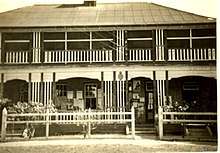
The Queensland Police-Citizens Youth Welfare Association was registered under the jurisdiction of the Police Department on 20 May.[1]
1949
There were 100 cars in use across the state representing brands such as Ford, Buick, Chevrolet, International, G.M.C, Mercury, Hudson, De Soto, Dodge and Plymouth.[1]
Fingerprint Expert Cecil Smith and two Queensland Detectives make history when they take hand and palm prints from almost the entire population of Ocean Island (now Banaba Island) to catch a double murderer.[1]
John Smith becomes the eight Police Commissioner on 24 July 1949.[1]
1950s
1950
Radio transmissions were made from Mount Coot-tha and the switch from amplitude modulated (A.M.) mobile equipment to frequency modulated (F.M.) equipment was made.[1]
Road safety lectures were introduced into schools and kindergartens. Puppets were used to illustrate scenarios for younger children and older children were taught to cross the street and to ride a bicycle safely.[1]
After an inquisitive cow fell into a ditch at the rear of the Queensland Woollen Mill in Ipswich, police were called to perform a rescue operation. Using a small crane, the heavy beast was successfully winched from the ditch and suffered only shock.[1]
There were fourteen police districts and 338 stations throughout Queensland at 30 June. Somerset police station was re-established and a new station was opened at Kenilworth.[1]
The Police Force was staffed by 2030 sworn personnel, 10 women police and 30 trackers. The State population had reached one million.[1]
1951
The Central Communications Room opens at the CIB building in Brisbane and becomes the nerve centre of police communications through the state.[1]
1954
Police radio stations were operating in Brisbane, Rockhampton and Townsville.[1]
The British Empire Medal for Meritorious Service originally established in 1922, was first awarded to Constable Noel Haupt on 17 October.[1]
The Kings Police and Fire Services Medal was split into two awards, the Queens Fire Service Medal and the Queens Police Medal for Gallantry which was first awarded posthumously to Constable 1/c Roy Doyle on 1 April 1956.[1]
The Kings Commendation for Brave Conduct became the Queens Commendation for Brave Conduct. It was first awarded to Constable Clifford Lebsanft on 11 May 1956.[1]
1955
Women were permitted to join the Queensland Police Union.[1]
The Brisbane Traffic Branch was established as an entity separate from the Brisbane Police District.[1]
Patrick Glynn becomes the ninth Police Commissioner on 6 January 1955.[1]
1956
The Union's application for equal pay fails in the Industrial Court.[1]
The state was affected by cyclonic disturbances and flood conditions resulting in widespread interruption to communications and damage to property.[1]
On 1 April Constable First Class Roy Doyle died in hospital at Mackay from head injuries sustained when he hit a submerged block of concrete while attempting a rescue in the flooded Pioneer River at Mackay on 29 March.[6]
On 1 May the awarding of the Police Long Service and Good Conduct Medal, originally proclaimed by King George VI in 1951, was extended to include the states of Australia by Queen Elizabeth II. The medal was awarded after twenty-two years of approved police service and 378 police officers qualify.[1]
1957
208 centres were sharing 384 vehicles and 126 horses – 73 cars, 113 utilities, 37 land rovers, 6 vans, 155 motorbikes and 179 bicycles.[1]
Thomas William Harold becomes the tenth Police Commissioner on 1 April 1957.[1]
Two Traffic Branch officers attend the "Traffic Engineering Course" offered by the New South Wales University of Technology.[1]
Police Commissioner Harold puts into operation four radio-equipped prowl cars to cruise the city and suburbs through the night.[1]
1958
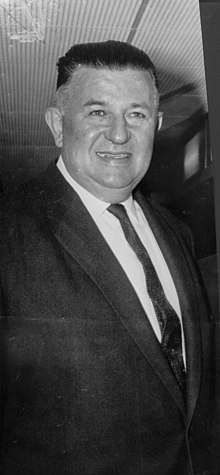
The British Empire Medal for Gallantry was established on 14 January. First awarded to Constable James Boyle on 7 August 1959.[1]
Francis Erich (Frank) Bischof becomes the eleventh Police Commissioner on 30 January 1958. With a view to raising the morale and status of newly sworn-in personnel, Bischof decides to inaugurate Passing Out Parades for Probationaries. The first parade was held on 29 May with twenty-four men being sworn.[1]
The Queensland Police Pipe Band makes its first public appearance on 29 August at a passing out parade at the Petrie Terrace Police Depot.[1]
1959
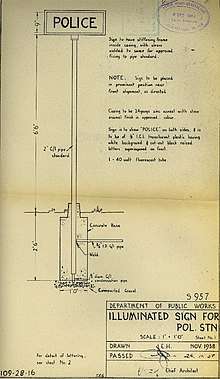
The Stock Investigation Squad was formed, with a detective sergeant and three plainclothes members.[1]
Following complaints that police stations were not readily identifiable, the Queensland Department of Works was asked to supply conspicuous illuminated signs showing POLICE in black letters on a white background. On 5 May 1959, a sample illuminated sign was erected at Holland Park Police Station and with that success, an order was placed with Albert Smith and Son to manufacture these signs. Over the next decade the illuminated signs were progressively installed at stations and the old style cast iron badges were returned to the Police Depot. Sometime in the late 1960s the illuminated word POLICE, was produced in white letters on a black background, and in the mid 1980s a blue light was added to the top for more effect.[7]
Sub-Inspector Cecil Smith was appointed as the first Queensland Police Public Relations Officer on 6 July. He was expected to make regular telecasts on topical police matters by way of the new technology of television.[1]
1960s
1960
Detective Senior Sergeant Les Bardwell, Constable Barry Short and Cadet Neil Raward were the only three scientific officers servicing the state.[1]
A new range of drab olive uniform and a new cap badge were introduced.[1]
1961
A new insignia was introduced which was an adaptation of the police badge. It bears the Latin motto "Constantia ac Comitate" (English translation: Firmness with Courtesy).[1]
1962
The old Queensland Egg Board building, on the corner of Makerston Street and North Quay was purchased and converted into a Police Headquarters.[1]
.38 Smith and Wesson revolvers were purchased to enable the standardisation of firearms.[1]
On 19 February Constable Gregory Olive was shot in the chest at close range when he knocked on a front door to make inquiries at Kelvin Grove, Brisbane.[6]
On 16 August Constable Douglas Wrembeck stopped to question a motorist in South Brisbane and was killed when he was struck by a car driven by a hit-and-run driver.[6]
1963
The Juvenile Aid Bureau was established to guide potential youthful law breakers on the right path and prevent them from incurring a court conviction.[1]
On 14 February Senior Constable Cecil Bagley was electrocuted when he tried to rescue a neighbour being electrocuted in his car at Mount Gravatt, south Brisbane. Although at home, his death was deemed to have occurred while on duty because, as a police officer, he was always expected to respond in an emergency situation.[6]
1964
On 30 June the police strength equals 2760 police officers (1 police officer to 571 people).[1]
On 26 October Senior Constable Desmond Trannore was shot attending a domestic disturbance near Gordonvale, North Queensland.[17]
1965
On 31 March, eight serving plainclothes women police were sworn in and given equal powers and rank as male officers. In June the first uniformed women were sworn in following regular probationary training.[1]
Twenty-one new Cortina sedans were purchased for traffic work.[1]
179 cars, eight vans, eighteen motor cycles, one bus and one utility truck were fitted with two-way wireless. Twenty-three cars and three utility trucks were fitted with two-way wireless.[1]
The first set of specially chosen police was trained for a "Rescue 8" Squad to handle major incidents and disaster emergencies.[1]
The first ever issue of attire for policewomen was a female version of the drab olive uniform.[1]
1966
Sergeant 2/c Colin Ward and Constable Colin Tapsall installed the first police-owned UHF radio linking system from Saddle Mountain near Kuranda, to the Cairns Airport.[1]
1968
All new CIB Detective appointees were required to attend a course of training that includes lectures by senior experienced detectives, films and practical application.[1]
The Company Squad was reorganised as the Fraud Squad.[1]
On 27 March Constable Douglas Gordon was shot and killed attending a domestic disturbance at Inala, in south Brisbane.[17]
On 26 June the Crime Prevention Bureau commences operation, for the purpose of providing two police officers in a full-time capacity to impart security and personal safety advice to community members.[1]
The Emergency Squad was established principally to deal with the apprehension of armed offenders.[1]
A World War II sea mine washes up onto the beach at Surfers Paradise, shocking those enjoying the sun, sand and surf. The device was successfully deactivated and removed by the Royal Australian Navy with the help of Gold Coast police.[1]
1969
Printing of Volume 1 of the new "Queensland Policeman's Manual" was completed and preparation of Volume 2 was well advanced.[1]
Probationaries receive training in the use of Breath Testing Devices (Alcotest) and Breath Analysing Instruments (Breathalyser).[1]
Norwin William Bauer becomes the twelfth Police Commissioner on 14 February.[1]
On 9 April Senior Constable Colin Brown was shot and killed while investigating the behaviour of a farm employee on a property near Dayboro, north of Brisbane.[17]
1970s
1970
The number of policewomen equals twenty-seven. Postings extend outside central Brisbane and to provincial centres.[1] The Queensland Police Union achieves equal pay for women with the support of Police Commissioner Ray Whitrod.[1]
The position of Assistant Commissioner (Crime) was established.[1]
The Queensland Police College at Chelmer commences operation on 27 January as an "in-service training centre".[1]
All newly-sworn Constables were sent, over a period of twelve months, to different metropolitan police stations for on-the-job training.[1]
Raymond Wells Whitrod becomes the thirteenth Police Commissioner on 1 September 1970.[1]
1971
Police and protestors clash over the South African Springbok football team's tour of Queensland.[1]
The minimum height for women joining was set at 162.5 cm and the bar on married women joining up was removed.[1]
Consideration was given to the use of computers for police purposes.[1]
The Public Order Squad was formed with approximately 100 members, who provide staff for duty in connection with street demonstrations and similar disturbances.[1]
A new cadet training scheme was introduced. The three-year structure, combines senior examination subjects and special police courses.[1]
The Police Driver Training Wing was established and courses commence on 1 March.[1]
Stage 1 of the Queensland Police Academy at Oxley opens in January and the first 150 cadets were admitted.[1]
Uniform colour changes from drab olive back to blue. Policewomen wear a black skirt, white shirt with black tie and bowler style cap.[1]
1972
The Queensland Police Academy officially opens at Oxley on 24 March.[1]
In August 1972, the Queensland Police Force formed a Corps of permanent Police Prosecutors. This came about because of the need to improve the conviction rate in the Magistrate’s Court.[18]
1973
A Crime Intelligence course for Detectives commences at the Chelmer Police College.[1]
1974
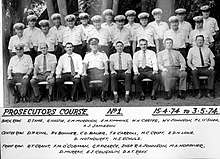
A Scenes of Crime Training Unit was opened at the Oxley Police Academy and a Scenes of Crime Unit becomes operational.[1]
First female detective was appointed.[1]
On 15 April 1974, the first official Prosecutor’s course commenced at the Police College at Chelmer.[18]
Two days after Cyclone Tracy devastates Darwin in the Northern Territory, twelve Queensland police officers arrive to lend a hand.[1]
1975
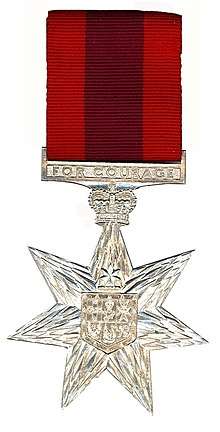
The Police Air Wing was established with the purchase of two Cessna 180E aircraft. Four police officers and qualified pilots were attached to the Wing.[1]
The Rape Squad, comprising seven female constables, commences working from within the Information Bureau.[1]
The quota system for the recruitment of women was removed and integration was adopted in deployment. Police Commissioner Whitrod's open door policy results in an influx of women.[1]
Final year Cadets and Probationaries receive twenty-three training periods in crowd control, prisoner control and crisis-situation handling.[1]
The Star of Courage, the second highest Australian bravery decoration, was established in the Australian honours system in February. It is awarded for acts of conspicuous courage in circumstances of great peril. Only four have been awarded to Queensland police officers, the first to Constable Rodney Edward on 16 March 1988.[1]
A new system of identification numbers and rank boards with metal chevrons were introduced for all ranks.[1]
On 2 November Senior Constable Lyle Hoey died after being deliberately run down by a car near Mount Molloy in North Queensland.[17]
1976
The number of Queensland policewomen equals 308.[1]
All police centres across the state have access to a motor vehicle.[1]
The Electronic Data Processing Unit was reorganised into the Planning and Research Branch and begins developing computer programs to make information available on criminal statistics, stolen vehicles, staff deployment, and vehicles of interest.[1]
Forbes House in Makerston Street was purchased and converted into Police Headquarters and officially opens 7 March.[1]
Terence Murray (Terry) Lewis becomes the fourteenth Police Commissioner on 29 November 1976.[1]
1977
Three new police vessels were commissioned: D.G. Gordon, G.J. Olive and Lyle M. Hoey.[1] They were named after three police officers who were killed in the line of duty.
The first step was taken in the automation of the colour printing process for the Photographic Section.[1]
Experienced journalist Ian Hatcher was appointed as the first Police Press Officer on 29 August. His responsibilities were to liaise with media and to publicise the work and improve the public image of the Force throughout the State.[1]
In January, Police pilot Sergeant 2/c Ron Rooke successfully carries out flood relief operations in the Camooweal, Burketown, Hamilton, Boulia and Doomadgee areas by dropping several hundred kilograms of food to stranded motorists.[1]
1978
The recruitment of female cadets was stopped but the quota for the recruitment of female adult probationers was revived.[1]
A computer systems training officer was appointed to train police officers in the correct use and operation of computer equipment for practical police work.[1]
1979
To give the public and the police an appreciation of the history of the Police Force, the Police Museum was fully open to the public on 17 May.[1]
On 12 March the Bomb Squad was reorganised as a two-man Arson-Bomb Squad and its activities were expanded.[1]
An armed man hijacked a commercial aircraft between Coolangatta and Brisbane and holds air crew and passengers hostage at Eagle Farm Airport. Emergency Squad personnel were deployed while a police negotiator secures the release of the hostages.[1][19]
Epaulette boards give way to shoulder patches and stripes of rank on the sleeves of new uniform. The Latin motto adopted on the shoulder patches was "Constantia Ac Comitate".[1]
1980s

1980
A new computerised message-switching system was introduced, with terminals installed in the metropolitan area and some district headquarters.[1]
Traffic branch motorcyclists were issued with blue leather caps which were worn instead of helmets while off their bikes and directing traffic.[1]
1981
The Rescue Squad was created within the Task Force in Brisbane. Members were trained in all types of rescue situations so that they could assist in bringing aid to people beset by accidents or disasters.[1]
1982
A new American Style highway patrol was formed to operate on country highways in an effort to cut down the road toll. The patrol fleet was equipped with 53 V8 Falcons with long range radios, as well as 84 Yamaha four cylinder 1100cc road motorcycles.[1]
1983
The first Blood Splash Pattern Evaluation Course was held.[1]
The Explosive Ordinance Reconnaissance Team was established which took the responsibility for bomb response from the Arson and Bomb Squad.[1]
The Latin motto on shoulder patches was replaced by the English translation of "Firmness With Courtesy".[1]
1984
The Police Department's own computer system comes online and ends the shared arrangements with other government departments.[1]
The Safety House program commences and provides a safe place for children in the event they feel threatened.[1]
Rain and mud hamper police attempts to remove protestors trying to prevent the construction of the Cape Tribulation to Bloomfield Road.[1]
On 29 February Constable Michael Low was shot and killed attending a domestic dispute at North Rockhampton, Central Queensland.[17]
On 22 June Queensland motorcycle police establish the Guinness Book of Records world record for the number of riders on a motorcycle, when 35 police officers balance on a motorbike at Surfers Paradise Raceway.[1]
1985
The Queensland police computer links to the Main Roads Department and the New South Wales police computer to increase access to information such as national stolen vehicles files.[1]
Adopt–a–Cop was introduced at Northgate State School, with Constable Michael Volk from Nundah Police Station eager to attend the school during lunch times to provide advice on road safety, bike safety and stranger danger.[1]
Long batons were purchased for use by members of Brisbane Mobile Patrols and the Brisbane Traffic Branch.[1]
1986
Queensland Police were officially linked to a central Finger-print Bureau in Sydney, which gives computer access to millions of prints throughout Australia and overseas.[1]
The Department operates 1,092 vehicles.[1]
There were 309 computer terminals in 121 locations. Training in computers was offered to Cadets and Probationaries at the Police Academy.[1]
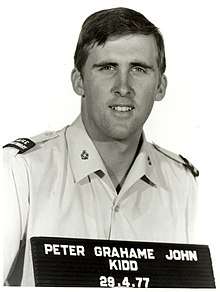
1987
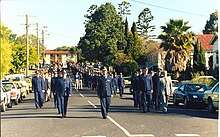
Under Police Commissioner Lewis the advancement of women was curtailed in most areas. The number of female sworn officers drops from over 8 per cent to 5 per cent.[1]
The Transport, Radio and Electronics Sections, Brisbane Mobile Patrols, and Traffic Accident Investigation Squad relocate to Alderley from the Petrie Terrace Police Depot.[1]
On 27 July the Fitzgerald Enquiry opens. It was a much needed, but painful organisational reform for the Queensland Police. Over the two years of the enquiry there were 238 hearings and 339 witnesses were called to give evidence.[1]
On 29 July Senior Constable Peter Grahame John Kidd was shot and killed in a raid at Virginia, in north Brisbane. The raid was to recapture an extremely dangerous escapee from Long Bay Jail who had subsequently committed several armed robberies. Kidd was the first member of the Tactical Response Team to enter the house. Having been shot through a closed door, Kidd continued to push through the door and returned fire. He then collapsed and died in hospital. Hundreds of police marched in Kidd's funeral procession held on 31 July. He was posthumously awarded the Queensland Police Valour Medal and the Star of Courage.[17][20]
On 21 September Ronald James Redmond becomes the Acting Police Commissioner.[1]
1988
The Neighbourhood Watch Unit commences operation on 22 February after a successful pilot program conducted on the Gold Coast. The program aims to reduce preventable crimes, improve personal and household security, reduce fear of crime, and provide support for victims of crime.[1]
1989
Crime Stoppers was established. Its role is to gather information from the community that will lead to offenders being caught and prosecuted.[1]
The first official video recording of a crime scene was conducted by the Photographic Section.[1]
On 29 June Constable Brett Handran was shot and killed attending a domestic dispute in Wynnum, in east Brisbane.[21]
Noel Newnham becomes sixteenth Police Commissioner on 1 November 1989.[1]
1990s
1990
Fitzgerald Enquiry recommendations augment the change from the Queensland Police Force to Queensland Police Service. A new badge was designed and the motto "With Honour We Serve" was approved.[1]
The first five female Inspectors were appointed.[1]
In May the Task Force was created in response to Fitzgerald Report recommendations. Its role was to support all regional commands through intelligence and co-ordination of crime operations.[1]
COMFIT, the electronic composition of faces from witness descriptions was developed by the Photographic Section.[1]
The Fingerprint Bureau, Photographic and Scientific Sections move to the 4th floor of the new headquarters building under the umbrella of the Forensic Services Branch.[1]
The new Police Communications Centre benefits from a two-million-dollar ESCORT Computer Aided Dispatch system that feeds instant information to mobile vehicles and foot patrols.[1]
The Queensland Police Service Valour Award was introduced to recognise police officers who perform acts of exceptional bravery in hazardous circumstances. First awarded in 1990 to Constables Kyle Bates, Edward Bennet, Neil Paulsen and Senior Constable Brendan Carew for a sea rescue.[1]
The Commissioner's Lantern Award was initiated to recognise and promote community-based policing. The inaugural 1991 winner was the Youth Assistance Panel project based in Townsville, joint initiative targeting petty juvenile offenders to provide a last chance before invoking the court system.[1]
The first custom built police headquarters was constructed on the block bounded by Makerston, Roma and Garrick Streets.[1]
New police badge, logo and the motto "With Honour We Serve" were adopted.[1]
In September the Computer Aided Despatch system was introduced which promises to improve the information available to, and increase the efficiency of, despatching police vehicles to incidents.[1]
1991
The Queensland Anti-Discrimination Act reinforces merit-based criteria in employment and the number of female recruits stabilises around thirty-three per cent.[1]
The Bureau of Criminal Intelligence develops and puts into operation the Queensland Intelligence Database with the ability to link nine different data categories.[1]
The Police Overseas Service Medal was established on 25 April to acknowledge the overseas peace-keeping role of police officers. The medal was awarded with a clasp which details the area of service.[1]
1992
The first female Chief Superintendent and Superintendent were appointed.[1]
The Queensland Equal Opportunity in Public Employment Act gives legislative support to initiatives to improve the position of women. These include flexible work options, anti-harassment strategies and mentor support.[1]
The Scientific Section relocates to the Roma Street Police Headquarters with more than 30 staff, many of whom specialise in a very select field of forensic identification.[1]
Electronic Recording Section becomes part of Forensic Services Branch[1]
The first Police Beat Shopfront was trialled at Rockhampton"s K-Mart Plaza and becomes a permanent establishment in August. This initiative was designed to provide an effective policing presence in shopping centres and to improve communication with the community.[1]
The Special Emergency Response Team was established to respond to emergency situations and to provide operational police with specialist support.[1]
An Executive Development Program commences to provide skills in strategic planning, policy development, resource management, and command and control to officers moving to commissioned rank.[1]
James Patrick O"Sullivan becomes the seventeenth Police Commissioner on 1 November 1992.[1]
1993
The offender identification computer system called Com-Fit was developed.[1]
The Task Force becomes the State Crime Operations Command with a primary function to generate intelligence about organised and major crime; and to support regional police during major criminal investigations.[1]
1994
The Public Safety Response Team was established as a full-time unit with a staff of forty-five.[1]
On 24 October twelve passengers on a Wide Bay Tours bus, die when it crashes on the Gateway Motorway. Police, ambulance, fire and emergency service workers, work together to assist the injured after the accident.[1]
The Police Recruit Operational and Vocational Education (PROVE) program was introduced to allow recruit curricula to be run on a wholly in-Service basis.[1]
Between 1994 and 1996 the Academy was renamed as the Queensland Police and Emergency Services Academy in acknowledgement of the continuing training initiative between the Queensland Police and Queensland Emergency Services.[1]
In May, a new $3.3 million police complex, consisting of police station and watchhouse, was officially opened on Mornington Island. It was one of only four cyclone resistant buildings on the island and could be used as a cyclone shelter if required.[1]
1995
In response to the recommendations of the Royal Commission into Aboriginal Deaths in Custody, the concept of Police Liaison Officers was initiated on Thursday Island and later trialled in Townsville.[1]
1996
The North Queensland Campus of the Police Academy was established in Townsville to encourage recruitment in central and northern Queensland.[1]
On 21 May Constable Shayne Gill was struck and killed by a motor vehicle while on radar duty on the Bruce Highway near Glasshouse Mountains.[22]
The North Queensland Police Service Academy in Townsville opens its doors for recruit training on 14 October.[1]
1997
The Violent Crime Analysis Unit was established to analyse victimology, modus operandi, offender information, forensic data and behavioural patterns.[1]
The Volunteers in Policing (VIP) trial program was initiated in September. VIP duties at police stations include victim support, witness support, customer service, school support and community liaison.[1]
1998
Bicycles patrols were re-introduced to Brisbane after a successful trial.[1]
The Interactive Crime Scene Recording System was developed by the Photographic Section.[1]
The laser speed gun was introduced; it uses LIDAR (Light Detection and Ranging).[1]
A range of new equipment was introduced which includes extendable batons, hinged handcuffs and Glock firearms.[1]
1999
Women make up 17.36 per cent of sworn personnel. The number of female sworn officers increases steadily by approximately one per cent per year.[1]
The Queensland Police Service Medal was introduced on 1 January, to recognise the diligent and ethical service by members of the Queensland Police Service.[1]
The Queensland Government transfers the community police function from Community Councils at Woorabinda, Yarrabah and on Badu Island, to the Queensland Police as a 12-month pilot. These officers were known as Queensland Aboriginal and Torres Strait Islander Police (QATSIP).[1]
2000s
2000
Kathleen Rynders was the first policewoman to achieve the rank of Assistant Commissioner and in 2008 becomes the first woman to rise to the rank of Deputy Commissioner.[1]
All manual fingerprints filing systems were replaced by the National Automated Fingerprint Identification System allowing all states to share fingerprint information.[1]
The DNA Implementation Unit was established to facilitate the introduction of new legislation allowing the QPS to use DNA as a forensic investigative tool.[1]
The Crime Prevention Personal Safety Team develops a larger than life wooden figure named "Duncan" to assist in teaching children to pay attention to their gut feelings when they feel in danger.[1]
On 21 July 2000 Senior Constable Norman Watt, 33, was shot during an armed stand-off near Rockhampton in Central Queensland.[21]
Robert Atkinson becomes the eighteenth Police Commissioner on 1 November 2000.[1]
2002
In March 2002 co-ordination and security for Commonwealth Heads of Government Meeting involves the largest security operation ever staged by the Queensland Police.[1]
A dedicated cold case team was established within the Homicide Investigation Group.[1]
In March co-ordination and security for Commonwealth Heads of Government Meeting was managed by the Queensland Police Service. More than 4,000 police and staff members take part in the security operation.[1]
2003
Constable Mokhtiar Singh creates history as the first Sikh to be sworn in as a Queensland police officer. His uniform includes an adaptation of the traditional Indian turban in recognition of his cultural heritage and religious beliefs.[1]
Thirteen Queensland Disaster Victim Identification Squad officers were deployed to Bali, as part of an Australian contingent, to assist the Indonesian Government following the terrorist attack.[1]
The Oxley Police Academy delivers a Justice Entry Program targeted at Aboriginal and Torres Strait Islander people.[1]
On 22 August 2003 Senior Sergeant Perry Irwin, 42, was shot while investigating reports of gunfire in bushland at Caboolture, north of Brisbane.[21]
2004
Queensland police begins the sharing and searching of DNA samples from people and crime scenes at a national level on the newly operating National Criminal Investigative DNA Database (NCIDD).[1]
2005
In February the Service opens a Police Dog Development Complex, hoping that their own dog breeding facility will overcome a general lack of trainable dogs.[1]
Bright red, two door Monaro Highway patrol cars were introduced.[1]
As at 30 June there were 9310 police officers and 3153 support staff.[1]
The "Forensic Register" was fully deployed for remote data entry to provide a "paperless" case file solution at a scene of crime. All forensic film based cameras were replaced with digital SLR cameras to record crime scenes.[1]
Three new Queensland police awards were established: the Commissioners Commendation for Bravery, Commissioners Certificate for Notable Action and Commissioners Award for Meritorious or Special Service.[1]
The Commissioners Commendation for Bravery was first awarded to Senior Sergeant Mathew Rosevear, Sergeants Robert Duncan and Richard Downie; Constables Glen Lamont, Kim Adamson and John Lima.[1]
The eligibility criteria for the Humanitarian Overseas Service Medal originally established in 1999, were amended to enable recognition of humanitarian service provided in response to national disasters overseas. First awarded to Senior Sergeants Kenneth Rach and Scott McLaren for their disaster victim identification work after the Thailand tsunami in 2014.[1]
Queensland police, Cardwell Lions Club and Cardwell Coast Guard go into partnership to provide free EPIRBs to departing bush walkers on the Thorsborne Trail on Hinchinbrook Island and Herbert River Gorge walk. The project aims to help rescuers find lost or injured hikers more quickly.[1]
On 18 July 2007, Constable Brett Irwin, 33, was shot while executing an arrest warrant for breach of bail at Keperra, in northwest Brisbane.[21]
2006
QPRIME a major new policing information system was launched. The system is used to record and manage all reportable police incidents. It allows easier access to information, less time is spent searching for information in different systems and reduces manual and paper-based processes.[1]
The Live-scan fingerprint scanning system was successfully rolled out across the state. These units were connected to the Crimtrac National Automated Fingerprint Identification System in Canberra.[1]
2007
The Photographic Section goes digital and acquires a digital mini-lab which means that photos taken at any Queensland crime scene were processed and printed almost immediately.[1]
2008
Operation Achilles concludes after more than 2 years of investigation resulting in the simultaneous execution of warrants across the world and the arrests of child sex offenders in Australia, the United States, Germany and the United Kingdom.[1]
The publication of district-based Neighbourhood Watch Crime Bulletins was launched in Cairns in October. Crime Bulletins provide information to the community to assist in clearing offences, and to provide details about crime prevention initiatives.[1]
2009
The eligibility criterion of the Queensland Police Service Medal was changed and was made available to living former members who served prior to the introduction of the medal in 1999.[1]
Newly designed patches and epaulettes were introduced. Epaulettes for the ranks of Senior Sergeant and below, now incorporate the words "Queensland Police".[1]
2010s
2010
Policelink was established to provide an alternative point of contact for reporting non-urgent crimes or incidents and for general police enquiries. A new national non-urgent police number was introduced.[1]
The National Police Service Medal was established on 9 November and recognises the special status that sworn police officers have because of their role protecting the community and represents a police officer"s past and future commitment to give ethical and diligent service. A minimum of 15 years' service is required to qualify for the medal.[1]
Communications Room Operator Andrew Heinrich, took a call at the Ipswich Police Communications Centre around 9pm on 25 September and remains calm and in control as he gives the mother CPR instructions to resuscitate her unconscious baby girl.[1]
The Fortitude Valley police station redevelopment project comprises two stages, the construction of a two-level "operational" building and the refurbished of the existing 1936 building.[1]
2011
Eight years after thirteen year old Daniel Morcombe was abducted from a Sunshine Coast road, an extensive police investigation locates and charges his killer with murder.[1]
The use of Automatic Number Plate Recognition technology was launched state-wide. The initial launch consisted of one unit being located at the State Traffic Support Branch for use in statewide traffic operations involving both specialist and local police.[1]
The floods of 2011 initiate the first use of Facebook and Twitter by the QPS Media and Public Affairs Branch to forge a direct link with the community by using social media to relentlessly issue accurate information and to fight rumours.[1]
Unprecedented floods affects much of Queensland and police were involved in all manner of support, including victim identification, missing persons coordination, anti-looting patrol and countless rescues in all manner of vehicles and vessels.[1]
On 29 May 2011 Detective Senior Constable Damien Leeding (CIB) was shot when he confronted an armed offender at the Pacific Pines Tavern on the Gold Coast. Leeding died in hospital on 1 June three days after being shot.[21]
2012
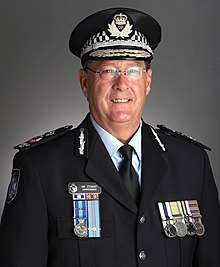
The introduction and implementation of the Automatic Number Plate Recognition project delivers significant improvement and efficiencies in frontline traffic operations.[1]
The new "Police Recruit Pathway" selects applicants based on physical health and fitness, personal integrity, cognitive ability and literacy, psychological suitability, life and work experience and practical policing skills.[1]
Ian Duncan Hunter Stewart becomes the nineteenth Police Commissioner on 1 November 2012.[1]
2013
A new recruit program commences in January that increasingly expects recruits to perform realistic policing roles.[1]
On 3 March an armed gunman brings business in the Queen Street Mall in Brisbane to a halt. The situation was brought under control by the swift action of operational police and the Special Emergency Response Team.[1]
The Fatal 5 campaign on HSV Holdens, was launched which adds "inattention" to "speed", "seat belts", "drink driving" and "driving tired" as the main causes of traffic crashes. The campaign was designed to catch the attention of road users and prompt them to be more careful on the roads.[1]
Under the Queensland Police Renewal Program the newly named State Crime Command includes the Child Safety and Sexual Crime Group, Drug and Serious Crime Group, Fraud and Cyber Crime Group and the Homicide Group.[1]
The strength of the Queensland Police Service at 30 June was 11,055 police officers, 371 police recruits and 3705 staff members.[1]
On 1 July, a new structure was approved and which means the reduction of Regions from eight to five and Districts from thirty to fifteen.[1]
Women make up more than twenty-five per cent of sworn personnel and serve in many varied roles across the state.[1]
The most northerly police station was on Thursday Island, the most southerly police station was at Hungerford, the most westerly station was at Camooweal and the most easterly police station was at Coolangatta.[1]
On 1 July the Forensic Services Group forms as a result of the QPS review. It consisted of more than 550 staff and encompasses all district scenes of crime units, the Fingerprint Bureau, the Forensic Intelligence Unit, and the DNA management, Photographic and Electronic Recording and Scientific sections. The FSG processes in excess 150,000 requests for service and positively identifies or links several thousand suspects to their crime each year.[1]
The mobile data pilot for smartphones and tablets was rolled in October as part of the move to provide the technology required by police to keep the community safe.[1]
At the Queensland Police Excellence Awards, Southern Region wins the Gold Lantern Award for Excellence in Problem-Oriented and Partnership for their "Stay on Track Outback" initiative which aims to enhance road safety on the rural and remote highways of outback Queensland.[1]
New uniform material was approved which is lighter in weight and more breathable. The cloth is treated with a flash dry and incorporates a percentage of stretch for comfort and ease.[1]
There were more than 450 police establishments spread across the state.[1]
2014
Queensland Police celebrated their 150th anniversary.[1]
2017
On 29 May 2017, Senior Constable Brett Forte was shot and killed at Adare, north of Gatton, after attempting to apprehend a suspected offender. The gunman, Rick Maddison, was shot and killed the next day by police while trying to escape after a siege in a farmhouse at Ringwood, north-west of Gatton.[23] On 8 June 2018, the police helicopter POLAIR 2 was named Brett A. Forte in his honour.[24] POLAIR 2 had provided air support during the siege.[25]
References

- "Policing Queensland Timeline 1864 - 2014". Queensland Police Museum. 7 July 2017. Archived from the original on 4 November 2018. Retrieved 4 November 2018.
- Jones, Lisa (4 June 2019). "FROM the VAULT – Single officer stations". Queensland Police Museum. Archived from the original on 5 June 2019. Retrieved 5 June 2019.
- "ROLL OF HONOUR 1867 - 1883". Queensland Police. Archived from the original on 1 June 2017. Retrieved 1 June 2017.
- "ROLL OF HONOUR 1889 - 1903". Queensland Police. Archived from the original on 1 June 2017. Retrieved 1 June 2017.
- "James Sangster Memorial (entry 602581)". Queensland Heritage Register. Queensland Heritage Council. Retrieved 30 November 2018.
- "ROLL OF HONOUR 1904 - 1963". Queensland Police. Archived from the original on 1 June 2017. Retrieved 1 June 2017.
- Jones, Lisa (23 July 2019). "FROM the VAULT – Police Station Identification – A Sign of the Times". Queensland Police Museum. Archived from the original on 25 July 2019. Retrieved 25 July 2019.
- "CONSTABLE'S DEATH". Daily Standard (5620). Queensland, Australia. 19 January 1931. p. 15. Retrieved 12 September 2018 – via National Library of Australia.
- "From the Vault – A Fitting Farewell". Queensland Police Museum. 11 September 2018. Archived from the original on 12 September 2018. Retrieved 12 September 2018.
- "Two Policewomen Appointed". Daily Standard (5653). Queensland, Australia. 26 February 1931. p. 1. Retrieved 28 November 2018 – via National Library of Australia.
- "General". The Queenslander. Queensland, Australia. 17 May 1934. p. 5. Retrieved 28 November 2018 – via National Library of Australia.
- "SURPRISE ANNOUNCEMENT". Cairns Post (9964). Queensland, Australia. 11 January 1934. p. 6. Retrieved 28 November 2018 – via National Library of Australia.
- "FROM the VAULT – Queensland Police Ball, 1934". Queensland Police Museum. 18 September 2018. Archived from the original on 29 November 2018. Retrieved 30 November 2018.
- "Fortitude Valley Police Station (entry 601168)". Queensland Heritage Register. Queensland Heritage Council. Retrieved 1 August 2014.
- "TERRIBLE QUEENSLAND AIR DISASTER". Worker. 49 (2682). Queensland, Australia. 29 November 1938. p. 28. Retrieved 12 September 2018 – via National Library of Australia.
- "FROM the VAULT – The death of Constable George Young, 1938". Queensland Police Service. 22 October 2013. Archived from the original on 12 September 2018. Retrieved 12 September 2018.
- "ROLL OF HONOUR 1964 - 1987". Queensland Police. Archived from the original on 1 June 2017. Retrieved 1 June 2017.
- Jones, Lisa (21 August 2019). "Sunday Lecture Series – Sunday 25 August – Police Prosecutions". Queensland Police Museum. Archived from the original on 22 August 2019. Retrieved 21 August 2019.
- "T.A.A. HOSTESS, CREW OVERPOWER MAN Aircraft hijack attempt foiled". The Canberra Times. 53 (15, 965). Australian Capital Territory, Australia. 9 June 1979. p. 1. Retrieved 5 November 2018 – via National Library of Australia.
- "FROM the VAULT – 30th Anniversary of the death of Senior Constable Peter Kidd". Queensland Police Museum. 18 July 2017. Archived from the original on 30 November 2018. Retrieved 1 December 2018.
- "ROLL OF HONOUR 1989 - 2011". Queensland Police. Archived from the original on 1 June 2017. Retrieved 1 June 2017.
- "In Remembrance: 1986-1996". Queensland Police. Archived from the original on 8 June 2017. Retrieved 9 June 2017.
- Kate Kyriacou; Thomas Chamberlin; Chris Clarke; David Sigston (30 May 2017). "Cop killer shot dead by police". The Courier Mail. Archived from the original on 2 June 2017. Retrieved 9 June 2017.
- "Polair 2 honour for slain Brett Forte". The Queensland Times. 8 June 2018. Archived from the original on 29 November 2018. Retrieved 30 November 2018.
- Smith, Erin (8 June 2018). "Polair 2 has been named after Senior Constable Brett Forte who was shot and killed on duty". The Courier-Mail. Retrieved 30 November 2018.
Attribution
This article contains material from:
- Policing Queensland Timeline 1864 - 2014, State of Queensland (Queensland Police Service) 2018, released under CC-BY-4.0 licence, accessed on 4 November 2018.
- FROM the VAULT – Single officer stations, State of Queensland (Queensland Police Service) 2019, released under CC-BY-4.0 licence, accessed on 5 June 2019.
- FROM the VAULT – Police Station Identification – A Sign of the Times, State of Queensland (Queensland Police Service) 2019, released under CC-BY-4.0 licence, accessed on 25 July 2019.
- Sunday Lecture Series – Sunday 25 August – Police Prosecutions, State of Queensland (Queensland Police Service) 2019, released under CC-BY-4.0 licence, accessed on 21 August 2019.
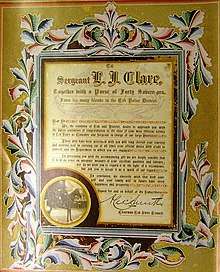
%2C_1961.webp.png)